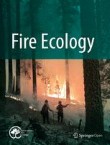Fire Ecology is the official journal of the Association for Fire Ecology.
Shrub Communities, Spatial Patterns, and Shrub-Mediated Tree Mortality following Reintroduced Fire in Yosemite National Park, California, USA
Shrubs contribute to the forest fuel load; their distribution is important to tree mortality and regeneration, and vertebrate occupancy. We used a method new to fire ecology—extensive continuous mapping of tre...
